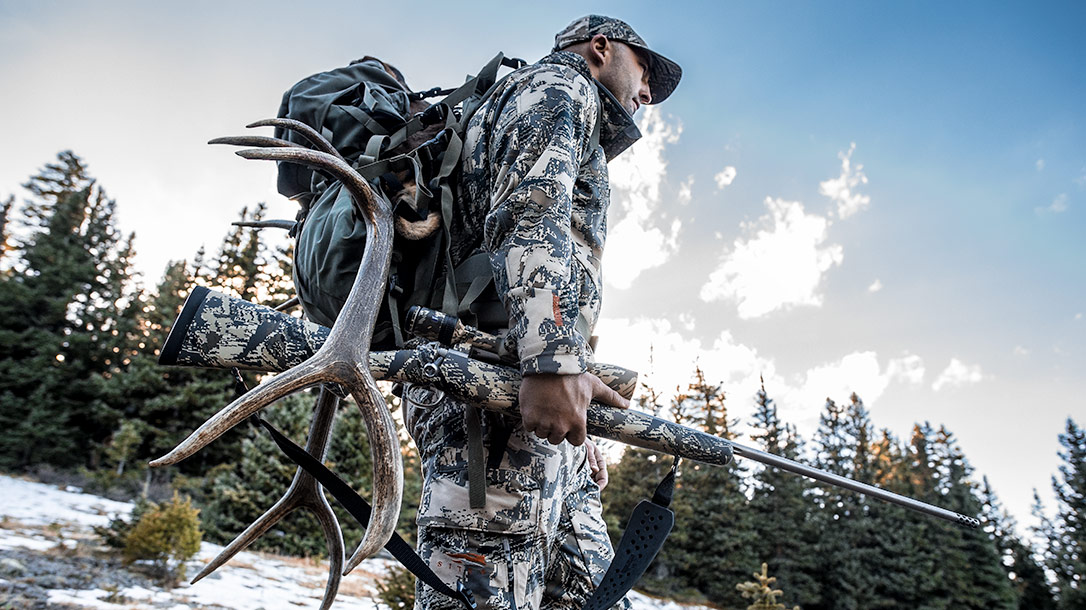My admiration for the time-honored .30-06 spans four decades, beginning with NRA High Power competitions during my college days. Over the years, I’ve enjoyed loading for, shooting and hunting with this versatile cartridge. I put this versatility to the test recently with the Kimber Mountain Ascent SubAlpine bolt-action rifle.
The Kimber Mountain Ascent Subalpine
My initial assignment was to provide some routine testing for the new Kimber during deer season. Unfortunately, it arrived too late to hunt with it, with an unfilled tag. Instead, I set out to find a proper load to turn this accurate, lightweight rifle into a varmint getter, since the coyote breeding season was fast approaching.
Typically, female coyotes come into estrus from January through March, making them a bit easier to call. Instead of just crying the “dying rabbit blues,” a few coyote vocalizations thrown into the mix will get a song dog’s attention more readily when they’re out cruising for a date. On the other hand, once a gravid female nears the end of her two-month gestation period, the males tend to be harder to call, and females all but impossible.
Advertisement — Continue Reading Below
Loading Up
I decided to cover the spectrum of possible loads for the new lightweight Kimber Mountain Ascent SubAlpine during this lull in coyote activity. I placed some emphasis on bullets in the lower weight spectrum.
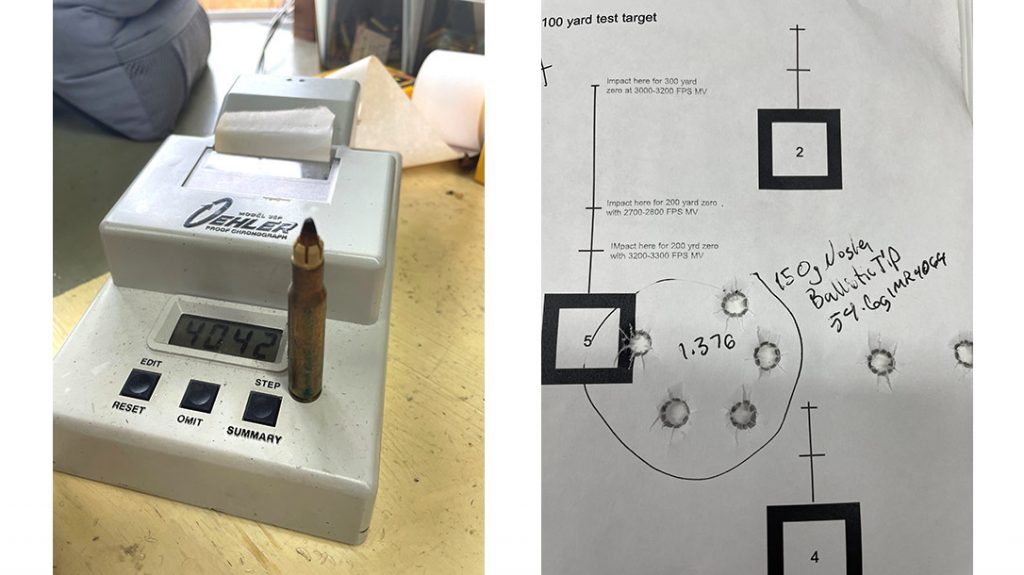
One of the attributes of loading for the .30-06 is the wide range of bullet weights that shoot well. You can readily find loading data for loads that start with 100-gran bullets, up to 220-grain, round-nose soft-points. Go any heavier with some of the modern .30-caliber heavyweight high-ballistic coefficient (BC) bullets in most .30-06 sporters, and they’re apt to fly sideways and backwards.
Advertisement — Continue Reading Below
Most factory .30-06 barrels are produced with a 1-in-10-inch twist, which is a tad slow for stabilizing bullets heavier than the old, low-BC “brush buster” 220-grain loads.
Surprising, too, is how fast the 115-year old cartridge can be pushed. It might be interesting to note that the .30-06 is capable of pushing a bullet beyond 4,000 feet per second (fps). Remington did it years ago with their Accelerator load. Big Green loaded a 55-grain .224 spire-point bullet into a sabot and offered them in .30-30, .308 and .30-06 back in 1977.
The now-discontinued round had a published muzzle velocity of 4,080 fps from .30-06 test barrels. A close friend gave me 18 rounds of the old “aught-six” Accelerator rounds 35 years ago, and I decided to see what they would do from the new Kimber, but you’ll have to stick around a few more paragraphs to see how they performed.
Advertisement — Continue Reading Below
Superior Versatility
I have heard claims that the .30-06 is the most versatile cartridge going, and that might be hard to disprove. One had to look no further than Hornady’s 11th edition of their Handbook of Cartridge Reloading for the way that company feels about it. “The .30-06 has the largest variety of suitable powders of the cartridges listed in the Hornady Handbook, which illustrates the efficiency of the cartridge.”
Gun Details
The Kimber Mountain Ascent SubAlpine may be the ultimate high-country mountain rifle. Weight-shaving standard features such as a carbon fiber-reinforced stock, fluted barrel, spiral-fluted bolt body and skeletonized bolt knob and extractor bring this lightweight rifle in at less than 5 pounds for some models. Specifically, the Mountain Ascent SubAlpine bolt-action rifle chambered in .30-06 tips the scales at 5.3 pounds.
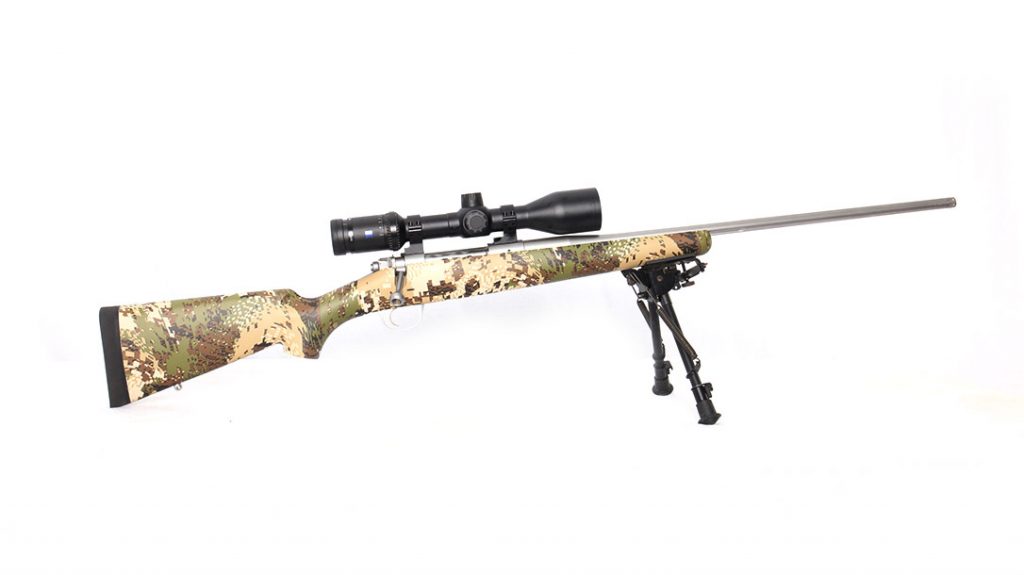
Advertisement — Continue Reading Below
This rig has an overall length of 43.75 inches with its 22-inch, half-fluted sporter contour barrel. The barrel material is stainless steel with a satin finish, and has four grooves with a 1-in-10-inch twist. At the muzzle, the barrel is threaded to attach the supplied muzzle brake. If you don’t want to hammer your unprotected eardrums while hunting with the muzzle brake, a supplied thread protector installs easily with a few quick twists.
This Kimber rifle features an excellent trigger. It’s adjustable, and Kimber claims to send it preset from the factory at between 3.5 and 4 pounds. This particular rifle has a 2-pound, 3-ounce trigger that breaks cleanly with virtually no creep or overtravel.
The Stock
Stock material is reinforced carbon fiber dressed in Gore Optifade SubAlpine pattern. To help tame recoil from this wisp of a rifle is a 1-inch pad. The length of pull measures 13.8 inches, the drop at heel is 0.54 inch and the drop at comb is 0.43 inch.
Advertisement — Continue Reading Below
To give this rifle’s accuracy potential a boost, Kimber chose to incorporate pillars to bed their Type 84L stainless steel action. The safety is a three-position Winchester Model 70 wing-style that allows the bolt to be locked, or swiveled to the mid-position to empty the chamber and still remain in the “safe” mode.
The bolt features a Mauser-style extractor, and locks up in the front with twin lugs. The bolt handle is “skeletonized” by adding flutes along its length, and the knob is hollowed out. The bolt’s external extractor spring even has weight-reducing through-cuts.
The optic chosen to scope this rig is a Zeiss Conquest V6 with a power range from 3X to 18X. The scope is set in lightweight Talley 30mm rings.
Advertisement — Continue Reading Below
Pet Loads
To see how versatile this rifle actually is with a wide variety of bullet weights, I started heavy and moved progressively lighter to culminate with an accurate, lightweight load. I used a mix of handloads to show versatility.
Starting with a 210-grain Berger VLD Hunting bullet and load data for the appropriate weight bullets, I bounced around among possible powders with three-shot test groups and settled on Reloder 19 as the best candidate. The final load was 57.4 grains, which pushed just beyond 2,600 fps. A couple of five-shot groups at 100 yards averaged 1.23 inches.
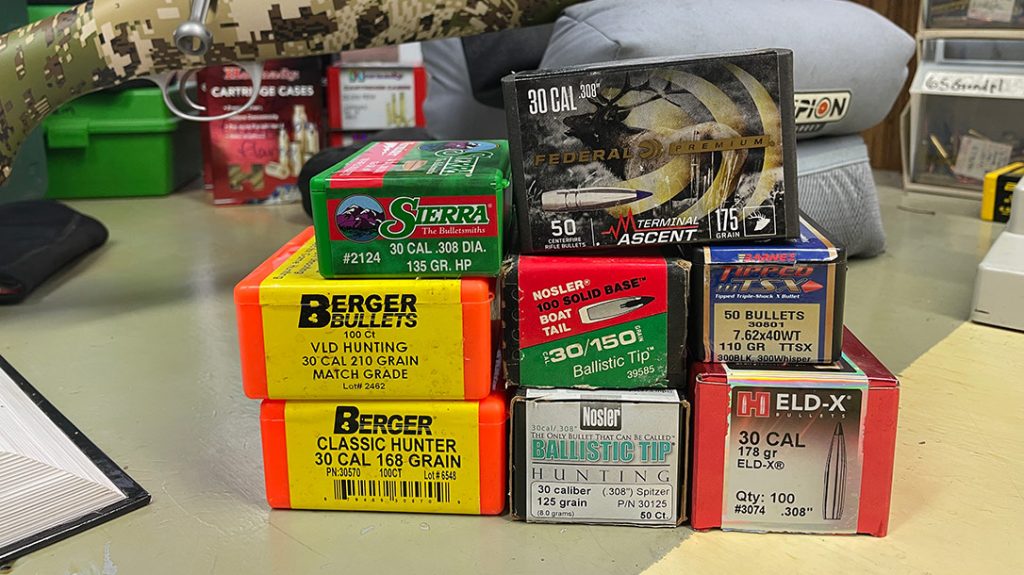
Advertisement — Continue Reading Below
170s
This weight is a little heavier than I prefer for smaller Eastern deer hunting with this cartridge, but it’s a good choice nonetheless for large-bodied deer and elk. Alliant Reloder 17 gets the nod, with a 55.7-grain charge as the maximum listed. I settled on 54.2 grains of RL-17, and from this rifle it averaged 2,714 fps when driving a Hornady 178-grain ELD-X. Accuracy for five shots at 100 yards saw 1.65 inches as its best.
Another well-constructed projectile for the .30-06 is Federal’s new 175-grain Terminal Ascent. A 53.4-grain charge of Hodgdon Superformance averaged 2,756 fps, and kept five shots under 1.35 inches at 100 yards.
160s
A moderate powder to drive 168-grain bullets in the Kimber is Hodgdon H4350. A maximum load listed is 58.4 grains, but I found that 57.6 grains was enough to drive a Berger 168-grain VLD Hunting a little north of 2,800 fps. This might be the ideal load for deer-sized game with this rifle.
Advertisement — Continue Reading Below
Zeroed at 200 yards, the bullet strikes 2 inches high at 100, just less than 8.5 inches low at 300 and you can stretch it out to 400 with a 24-inch holdover. This will easily handle about 98 percent of shots taken at deer across this continent this season.
150s
The .30-06 comes into its own with bullets in the 150-grain class. I would have to take my shoes off to count the number of different powders I’ve tried in the .30-06 with 150-grainers.
Sticking with a hunting bullet for the Kimber, I chose Nosler’s Ballistic Tip and started with 46.0 grains of IMR 4064. It produced groups hovering around 1 inch at 100 yards, so I upped the charges to 53.6 grains, and accuracy held up. The average velocity was 3,000 fps on the nose.
120s
I keep an ample supply of 125-grain .308 projectiles around for loading 300 AAC Blackout, so decided to give the Nosler Ballistic Tip 125s a whirl in the .30-06. IMR 3031 has been my “go-to” for .30-cal loads for bullets in this class. The maximum charge in Speer’s manual is listed as 54.0 grains, but this rifle preferred a lighter charge of 51.6 grains of 3031 to yield good accuracy. The average velocity was 2,910 fps.
110s
A go-to bullet for the 300 AAC Blackout 7.62×40 WT and the new .300 HAM’R has been the Barnes 110-grain TTSX. I keep an ample supply of these bullets on hand, and decided to try it in the Kimber. Picking Varget as the propellant, I settled on 57.1 grains. Averaging 3,312 fps, its scorching velocity didn’t do too shabbily in the accuracy department, either. The smallest group at 100 yards measured 1.270 inches. With its solid copper construction, it’ll handle any whitetail. And it’ll be a coyote hammer, too.
100s
Speer’s 100-grain Plinker is just that. You can push it to 3,425 fps with a 57.0-grain load of IMR 3031. Accuracy is moderate for five shots at 100 yards, and the smallest group I could manage was 1.45 inches. This bullet is perfect for making reduced loads, which can go as low as 16.0 grains of SR4759. This will lob these small pills downrange at about 1,500 fps.
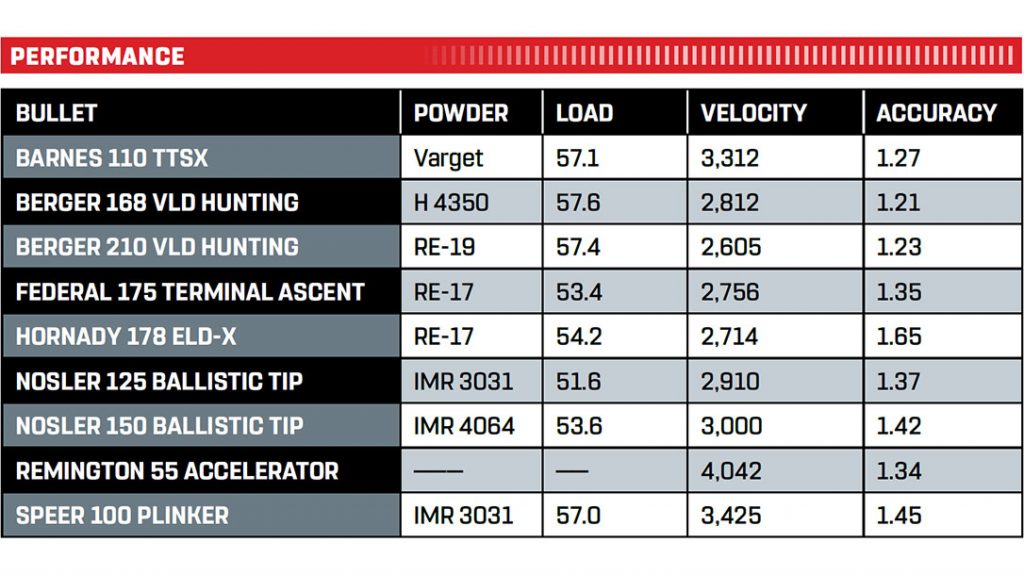
Hit the Gas
Loaded with specialty rounds, the .30-06 bumps its head on the Mach 4 category of cartridges. Remington’s Accelerator rounds cross a chronograph at 4,042 fps from this rifle . . . at least one did. I learned a long time ago that plastic sabots and Oehler 35P Skyscreens are not compatible. I’ve wrecked a set of Skyscreens in the past testing sabot-clad rounds, so I didn’t tempt fate with more than one shot.
Benchrest-level accuracy isn’t this rifle’s specialty, but portability as a hunting rifle is. It is more than capable of trips to the mountaintop and back, and if you have a shot on game at a quarter mile or less, it’s more than enough to get the job done. The time-honored success of the .30-06 has won a couple of World Wars, and it’s relatively easy to find factory fodder almost anywhere on the planet. Picking a bullet and powder might just be the biggest challenge for .30-06 handloaders, since there are so many from which to choose.
For more information, please visit KimberAmerica.com.
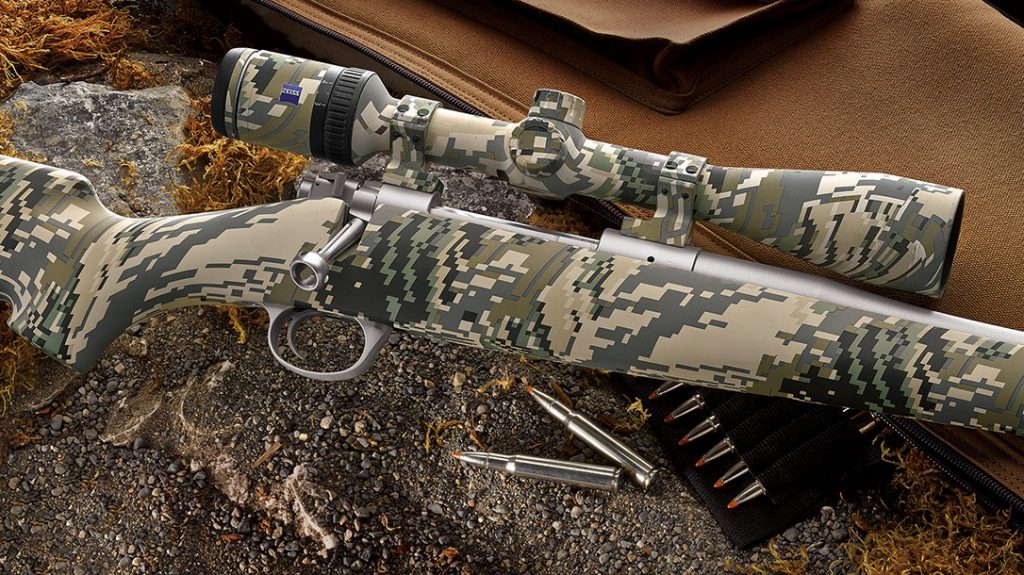
Kimber Mountain Ascednt Subalpine Specs
Caliber: .30-06
Barrel: 22 inches
OA Length: 43.75 inches
Weight: 5.3 pounds (empty)
Stocks: Carbon fiber
Sights: None
Action: Bolt
Finish: Satin
Capacity: 4+1
MSRP: $2,257
This article was originally published in the Complete Book of Reloading 2022 issue. Subscription is available in print and digital editions at OutdoorGroupStore.com. Or call 1-800-284-5668, or email subscriptions@athlonmediagroup.com.
